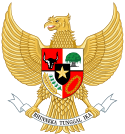Socjalistyczna Partia Indonezji
| Państwo | |
|---|---|
| Skrót | Parsi |
| Lider | |
| Data założenia | listopad 1945 |
| Data rozwiązania | grudzień 1945 |
| Ideologia polityczna | |
| Barwy | czerwony |
Socjalistyczna Partia Indonezji (indonez. Partai Sosialis Indonesia – Parsi) – socjalistyczna, indonezyjska partia polityczna założona 13 listopada 1945 roku w Yogyakarcie[1].
Historia
Partia została założona przez późniejszego ministra obrony narodowej Indonezji Amira Sjarifuddina. Trzon polityczny partii stanowili współtowarzysze Sjarifuddina z czasów walk narodowowyzwoleńczych w Jawie Wschodniej. Część z nich, jak chociażby Abdulmadjid, Moewaladi oraz Tamzil, brała aktywny udział w holenderskim ruchu oporu przeciwko nazistowskiemu okupantowi podczas II wojny światowej w Holandii[2].
W grudniu 1945 roku podczas zjazdu w Cirebon partia połączyła się z Socjalistyczną Partią Ludową tworząc Partię Socjalistyczną[3]. Amir Sjarifuddin został jej wiceprzewodniczącym. Pomimo powstania nowego organizmu politycznego, byli członkowie Parsi tworzyli bardziej radykalne skrzydło partii[4].
Przypisy
- ↑ R. Mrázek, Sjahrir: Politics and Exile in Indonesia. Studies on Southeast Asia, no. 14. Ithaca, N.Y.: Southeast Asia Program, Cornell University, 1994. str. 284-285.
- ↑ Ibidem.
- ↑ S. Rose, Socialism in Southern Asia. Londyn: Oxford University Press, 1959, str. 147.
- ↑ D. Legge, Intellectuals and Nationalism in Indonesia: A Study of the Following Recruited by Sutan Sjahrir in Occupation Jakarta. [Ithaca, N.Y.]: Cornell Modern Indonesia Project Publications, 1988. str. 121.
Media użyte na tej stronie
bendera Indonesia
State emblem of Indonesia is called Garuda Pancasila. The main part of the coat of arms is the golden mythical bird Garuda with a shield on its chest and a scroll gripped by its leg bears the national motto: "Bhinneka Tunggal Ika", roughly means "Unity in Diversity". The shield's five emblems represent Pancasila, the five principles of Indonesia's national philosophy. The numbers of feathers was meant to symbolize the date of Indonesian Proclamation of Independence; 17 feathers on each wings, 8 tail feathers, 19 upper tail feathers (under the shield, above the tail), and 45 neck feathers; all symbolize 17-8-1945; 17th August 1945. Garuda Pancasila was designed by Sultan Hamid II of Pontianak, and was adopted as national coat of arms on February 11, 1950.


